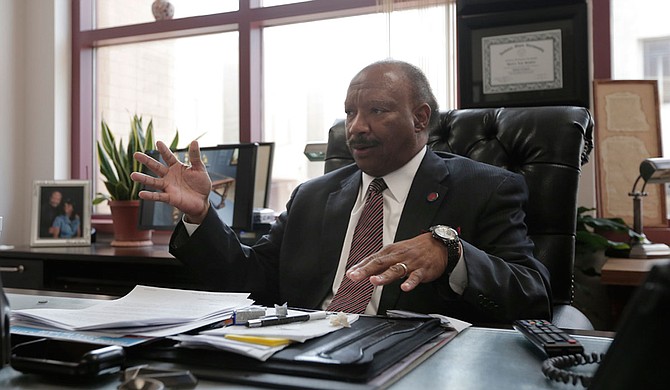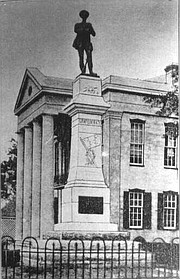Hinds County Board of Supervisors President Robert Graham told Marshand Boone, that the supervisors would start a process to move the Confederate statue in front of the Raymond, Miss., courthouse. Raymond is one of two county seats for Hinds. Photo by Imani Khayyam
The Confederate statue at the Hinds County Courthouse in Raymond represents racial injustice and should be removed, Marshand Boone told the Hinds County Board of Supervisors Monday. The board, in turn, committed to resolving the issue.
"Never before in the history of our nation have we had an honest conversation about systemic racism, racialized violence, brutality and white supremacy as we have after the May 25th murder of Goerge Floyd," Boone told the supervisors. "In this time of honest conversation, we have been pushing many things that we have accepted as facts, that are, in fact, vestiges of white supremacy."
Raymond is one of two county seats for Hinds County; the other is Jackson. It was the site of a pivotal point of the Civil War. The Battle of Raymond, on May 12, 1863, was part of the Vicksburg Campaign, with Confederate soldiers suffering many casualties in the fight against U.S. Army Maj. Gen. Ulysses S. Grant. Ultimately, the battle helped clear the way for Lt. Gen. John C. Pemberton’s surrender of Vicksburg to Grant on July 4, 1863. White leadership of Vicksburg refused to celebrate U.S. Independence Day for 80 years after the defeat.
More than 2,000 people watched the statue unveiled April 28, 1908, with seven little girls pulling ropes to remove the covering, the Battle of Raymond website reports. At the request of the United Daughters of the Confederacy, who pushed for Confederate memorials across the South, the Hinds County Board of Supervisors then allocated $4,000 to erect the monument, which Frederick C. Hibbard of Chicago designed. It was the same year that the Mississippi Legislature began allocating $50,000 in taxpayer dollars to erect Confederate memorials throughout Mississippi.
A journalist for The Clarion-Ledger attended the dedication of the statue in Raymond, later writing, "A red letter day and one of the greatest days in the history of Raymond."
While thanking today's board for previously speaking out in favor of removing the former Confederate-themed Mississippi state flag, Boone expressed sadness that 20 miles from where the board was meeting, a monument to the defenders of the Confederacy, dedicated in April 1908, still stands.
An inscription on the front of the Raymond statue reads: "Erected by the people of Hinds County, in grateful memory of their men who in 1861-1865 gave or offered to give their lives in defense of constitutional government and to the heroic women whose devotion to our cause in its darkest hour sustained the strong and strengthened the weak."
‘He Fought for White folks to Be Free’
Showing what the statue meant to him, Boone quoted from the 1861 Mississippi Declaration of Secession, where the state expressed the intention to secede from the north because it advocated Black equality.
”Mississippi (in the document) defined slavery one of the ‘greatest ... institutions in the world’, Mississippi also sought separation from the north because it advocated black ‘equality’, both ‘socially and politically,’” he said.
"It is time for action as such Confederate statues have been removed all over the country, and there is an ongoing conversation about renaming (military) bases named for the Confederate generals," he said. The Army Times reports that those bases include Fort Bragg in North Carolina, Fort Hood in Texas and Fort Lee in Virginia.
Boone told the supervisors that the soldier on the statue reminded him of his grandfather drafted into the military in 1942 for World War II, but who came back to live under pervasive inequality against his race, rather than hailed as a hero, which is what the statue represents for Confederate soldiers.
"He fought for white folks to be free. Blacks at that time have no real say so, or self-determination in their lives. So when the war was over, and America flew victoriously, it was white soldiers that got (called) the greatest generation."
Board President Robert Graham said the body has already begun the process of addressing the issue Boone brought forward.
"As I understand it, there are five (such) monuments (in the county). We understand your hopes, and we also understand your pain. And we are going to do everything that we can, hopefully, to relieve that pain and to emphasize that hope," he said.
District 2 Supervisor Archie said the board will reach out to those who live in the town of Raymond to resolve the issue and reach a collective and comprehensive decision on the action to take. Raymond is currently 53% black and 44% white.
"What we don't want to do is to react to folks that do not agree to (our) wishes the way they have reacted to the African Americans 60, 70, 80 years ago,” Archie said. “We want to be as fair as possible when it comes to any issue. We don't want to treat issues the way they have treated issues in the past."
‘The Embodiment of White Supremacy’
Board Vice President and District 3 Supervisor Credell Calhoun joined with Boone's sentiments, saying that "we have fought for this country and to have those kinds of monuments, and not do something about it as a board" is not acceptable.
District 4 Supervisor Vern O. Gavin said he had received correspondence from the town of Raymond about the alternative if the board chooses to relocate the statue of the Confederacy.
Boone stressed that the memorial does not honor all members of the society as the Confederate statue perpetuates the myth of Black inferiority and defends the right to own them as slaves in perpetuity.
"The Confederate monument is the embodiment of white supremacy, and is an affront to me, my grandfather and his descendants," he said. "This country was built on the backs of Black people, their blood, sweat and tears.
“The monument in Raymond regards that truth as inconvenient."
Email story tips to city/county reporter Kayode Crown at [email protected]. Follow him on Twitter at @kayodecrown.
More stories by this author
- City Council Votes on 2022 Legislative Agenda, Wants Land Bank, Water-Sewer Debt Forgiveness Extension
- Who Is the Hinds County Board of Supervisors’ President?
- JPS Starts In-Person Learning Tomorrow, Enhanced COVID-19 Protocol
- City Engineer: Despite Improvements, Severe Winter Storm Could Wreak Havoc
- Mississippi Supreme Court Appoints Senior Status Judge, Justice to Hinds County Cases



